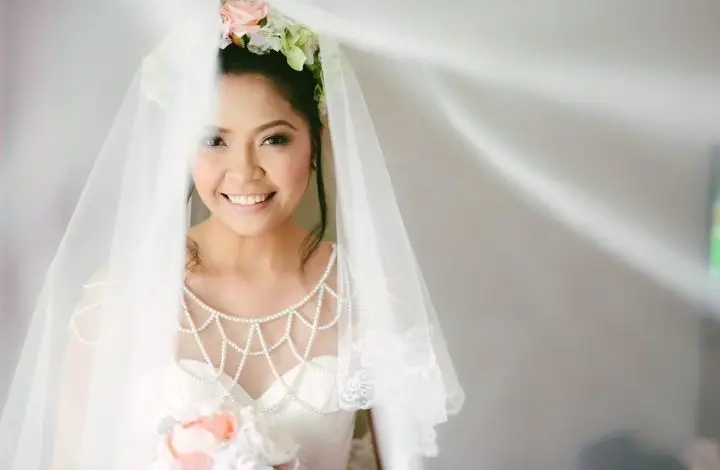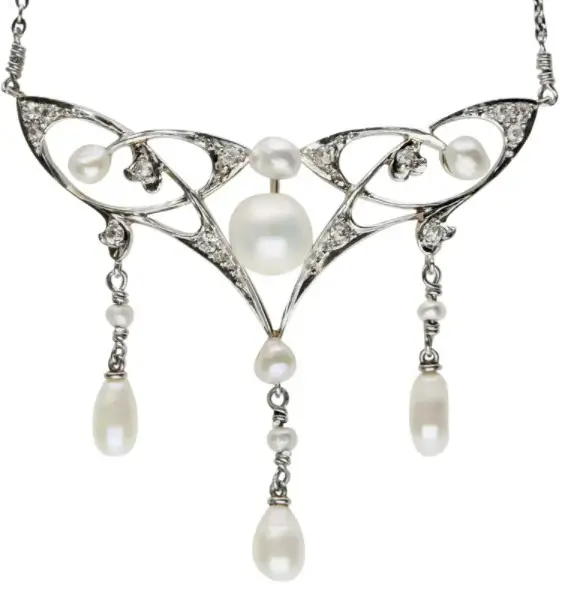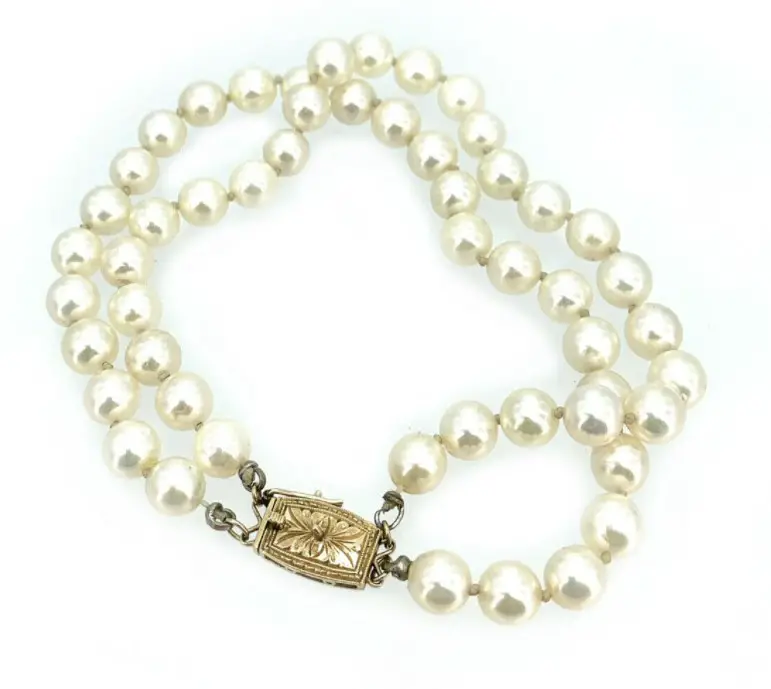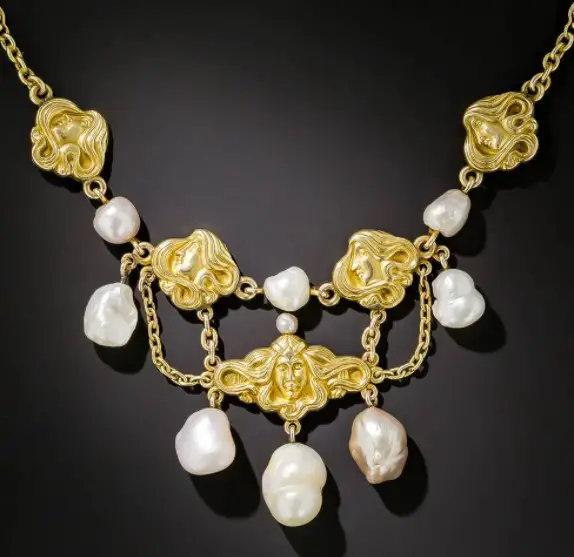Hey There! We may earn a commission from links on this page. This helps support the site and is at no extra cost to you. Thanks!
The pearl is a symbol of unblemished perfection. It is unique among gems—the only one created inside a living creature, a mollusk. For its unparalleled beauty, cool luster and exquisite shape, the pearl has been the choice of brides on their wedding day for thousands of years.
A Brief History of Pearls as Bridal Jewelry
The tale of the discovery of pearls is lost in the fog of prehistory. But let’s imagine our ancient ancestors foraging for food in shallow waters, breaking open a tasty oyster, and finding within a “ball,” shimmering and iridescent, more beautiful than anything they had ever seen. Of course, they would treasure it and endow it with divine powers.
The oldest pearl, found in the United Arab Emirates, is over 7,500 years old. In the 23rd century BCE in China, pearls were already valuable. A scribe records the inadequate gift bestowed upon the king of “strings of pearls not quite round.” A Hindu book from 1000 BCE tells the story of Krishna, one of the most revered divinities in Hinduism, bringing pearls from the depths of the sea to his daughter on her wedding day. Not only have pearls been around since antiquity, so has their association with weddings.
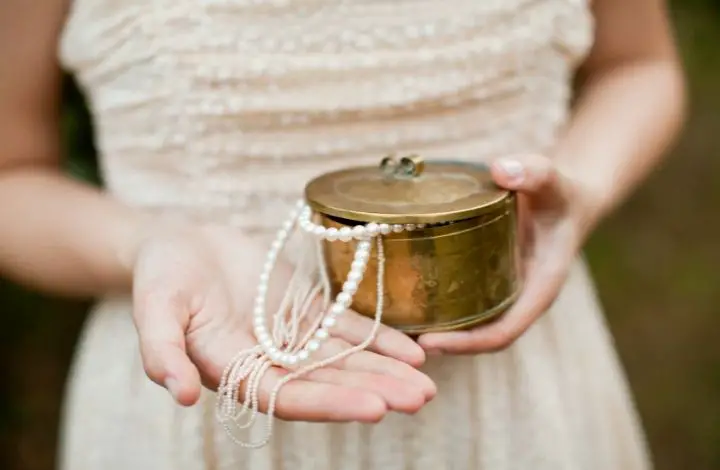
During the Dark Ages, knights fighting the Crusades wore pearls to protect them from harm. When (or if) they returned, they presented their fair ladies with the pearls to be worn on their wedding day. After the Crusades, new trade routes between the West and the Middle East and Asia made pearls “all the rage” with the upper classes in Europe, especially for weddings. For example, at a wedding in the French House of Burgundy, everyone was adorned in pearls—everyone from the bride to the male guests!
With the discovery of the New World, more sources of pearls were found. Natives in western areas of what is now North America were bedecked in magical pearls to ward off evil.
It was in the mid-19th century that the tradition of white wedding gowns began. Until then, brides wore a dress from their closet in any color they liked. Then Queen Victoria wore a white silk-spun gown at her wedding to Prince Albert. Women everywhere wanted to wear white on their wedding day. It was a special gown for a special day and not only denoted purity, it denoted privilege. Not everyone could afford an impractical white gown! That changed after World War II and the prosperity that followed. Middle class women could afford to copy the styles of the wealthy, and white wedding gowns were no longer a luxury. They were a must! And what better to complement them, and the beauty of the bride, but pearl jewelry.
Near the end of the 19th century, the pearl industry was revolutionized. In Japan, Kokichi Mikimoto was convinced that he could entice oysters to produce pearls. He invented a grafting needle to insert a piece of shell or metal into the oyster’s body to cause the tissue to form a pearl sack. The sack secretes nacre to coat the shell or metal and, voila, a pearl! Others invented similar tools, but Mikimoto is the most famous. This was the beginning of cultured pearls that have been worn for more than 100 years—pearls just as real and valuable as natural pearls.

Tips on Choosing Pearl Bridal Jewelry
These are simply guidelines. Fashion is fluid today. Do what you like!
- If you do not normally wear jewelry, don’t overdo it on your wedding day. You will be uncomfortable wearing too many pieces of jewelry and/or large statement pieces.
- Wear one focal piece of pearl jewelry and minimize any other jewelry. For instance, if you wear extravagant chandelier earrings, wear a simple necklace or earrings.
- If your wedding gown is heavily embellished, avoid large pearl jewelry.
- Enhance a vintage-inspired gown with a graduated strand of pearls, the style that prevailed in the 1940s and 1950s.
- If your gown is delicate, wear a necklace with small pearls.
- If your gown is modern and edgy, choose bold, large pearls.
- For a minimalist look, choose pearl studs or strands of smaller pearls, such as Akoya.
- To make a statement, wear large pearls such as South Sea pearls.
- You can include pearls without wearing jewelry: pearls as buttons on the gown, or as studs on the bodice of your gown, or as a border for your veil.
- Wear pearls in your hair on a comb or among a garland of flowers.
- For glamour and sparkle, pair pearls with diamonds. For example, simple pearl studs with a diamond halo.
- Dare to be different: Wear dark Tahitian pearls to contrast with the white gown.
Examples of Vintage Pearl Bridal Jewelry
Edwardian Natural Pearl & Mine Cut Diamond Lavalier Necklace
1900s. Set in platinum and 14K gold, the necklace features 11 natural pearls accented with 14 mine-cut diamonds for a total of .64 carats. Pendant measures 1 ¾ inches wide by 1 ½ inches long.
Mikimoto Double Strand Akoya Pearl Bracelet
Estate. This classic two-strand Akoya pearl bracelet has the Mikimoto emblem on the 14K yellow gold clasp. The pearls measure approximately 6.3mm. They are near round, with minimal blemishes, white in color with a yellow hue and excellent luster.
Art Nouveau Fresh Water Pearl Necklace
1910s. This Art Nouveau style choker necklace was fashioned in the early 20th century. A work of art, the design includes five nymphs with flowing tresses supporting five baroque freshwater pearls and three pearl separators. In the center is a tiny hair ornament. Necklace is 14 ½ inches long.
9 Strand Cultured Freshwater Pearl Bracelet
Estate. Nine strands of cultured freshwater pearls woven with gold thread and a 14K yellow gold clasp. Measures 7 ½ inches long.
Shopping for Authentic Vintage Pearl Jewelry
A consequence of pearls being so popular has been the increase in fake pearl production. Improvements in the manufacture of fake pearls means we have to be careful. Here are a few ways to tell real from fake.
- Fake or imitation pearls made from glass, plastic, alabaster or shells have a pearly coating to look like real pearls. Some can easily be spotted but others take a close examination. The most well-known fake and one of the most difficult to spot is the Majorca pearl made out of glass.
- Luster: Fake pearls will have a uniform shine. Real pearls have slight imperfections so that the luster isn’t exactly the same on all parts of the pearl.
- Uniformity: A fake pearl necklace will have pearls that are all the same size and perfectly round and without imperfections. Real pearls have very minuscule imperfections, as seen under a microscope.
- Color and Overtone: Fake pearls will be uniform in color. Real pearls feature very very subtle differences in color, as well as overtones that are a sliver different when compared to each other. Of course, real pearls would have differences—each pearl comes from a different mollusk.
- Weight: Fake pearls are light when compared to real pearls. But now counterfeiters are making the fakes from heavier materials (such as glass) so they are as heavy as real pearls.
Remember that any one of these methods cannot be used alone to determine if a pearl is real. Use a combination of them and enlist the help of an expert if you are suspicious.
[Read: How to Buy Pearl Jewelry Online]
Conclusion
See the “Vintage Pearl” pages on Etsy and on eBay. On any pearl jewelry site, read the descriptions carefully. Sometimes “vintage” means “vintage inspired” and “pearls” include “faux pearls,” a fancy French word for fake!

